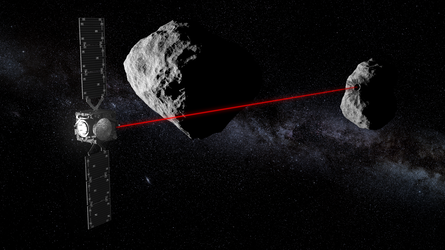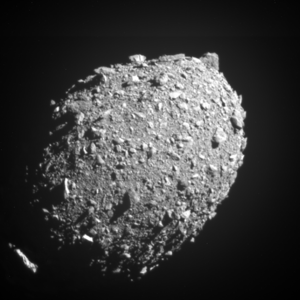Hera's Asteroid Deck and instruments
Hera's instruments are hosted on the top panel of the cube-shaped spacecraft body, known as the 'Asteroid Deck'. Hera's two CubeSats - Milani and Juventas - will also be deployed from here. The spacecraft will tilt itself so that its Asteroid Deck faces forward while operating its instruments - employed both for navigation purposes and scientific study.

[A] Asteroid Framing Camera, AFC - Incorporating two baffle-protected cameras for redundancy, each Asteroid Framing Camera is a 1020x1020 monochrome visible light sensor. Produced by Jenoptik in Germany, based on its ASTROhead design.
[B] Thermal Infrared Imager, TIRI - Imaging in the mid-infrared spectral region to chart the temperature on Dimorphos's surface. By charting the 'thermal inertia' of surface regions - or how rapidly their temperature changes - physical properties such as roughness, particle size distribution and porosity can be deduced. Supplied by the Japan Aerospace Exploration Agency, JAXA, from a design deployed on Japan's Hayabusa2 asteroid mission.
[C] Startrackers - Twin startrackers for space navigation from Sodern in France.
[D] HyperScout H - Observing in a range of colours beyond the limits of the human eye, in 25 visible and near-infrared spectral bands to help prospect the asteroid's mineral makeup. The shoebox-sized imaging spectrometer comes from cosine Remote Sensing in the Netherlands.
[E1 & E2] Deep Space Deployers for Milani and Juventas CubeSats - Keeping Hera's two CubeSats alive and healthy during their two-year cruise phase to the Didymos system then deploying them at Didymos. The DSDs come from ISISpace in the Netherlands with Finland's Kuva Space supplying the Life Support Interface Boards linking the DSDs safely to the rest of Hera.
[F] Laser Rangefinder - Determining the distance to the asteroid surface by measuring the time of flight of 1550-nm wavelength laser beam pulses. They are bounced back to a receiver telescope with a distance accuracy of better than 1 m and a working distance of 10 m to 20 km. Supplied by Jenoptik in Germany (plus a parallel development is ongoing with Efacec in Portugal and Eventech in Latvia).
[G] Spacecraft Monitoring Camera, SMC - This compact low-power and high-reliability camera gives a view of the entire Asteroid Deck. Equipped with a 4 Mpixel CMOS image sensor, the SMC will be used in particular to observe the deployment of Hera's two CubeSats and inspect them. Developed for ESA by TSD-Space in Italy with Italy's Optec SpA providing the optics.
[H] Inter-satellite links - For communication with Hera's CubeSats, developed by Tekever in Portugal.
[I] Low Gain Antenna - Backup for maintaining communications with Earth.
The accuracy of the experiment may be increased by adding information from the inter-satellite links between Hera and the deep-space CubeSats it will deploy – representing a first for Europe.
The CubeSats will carry additional scientific instruments, complementing Hera's own payload suite, including a radar to investigate the interior of Didymoon and an imaging spectrometer and a mass spectrometer to determine the mineralogical and elemental composition of Didymos and Dimorphos.















 Germany
Germany
 Austria
Austria
 Belgium
Belgium
 Denmark
Denmark
 Spain
Spain
 Estonia
Estonia
 Finland
Finland
 France
France
 Greece
Greece
 Hungary
Hungary
 Ireland
Ireland
 Italy
Italy
 Luxembourg
Luxembourg
 Norway
Norway
 The Netherlands
The Netherlands
 Poland
Poland
 Portugal
Portugal
 Czechia
Czechia
 Romania
Romania
 United Kingdom
United Kingdom
 Slovenia
Slovenia
 Sweden
Sweden
 Switzerland
Switzerland










































